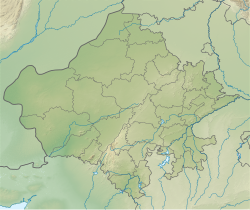| Bairat Temple | |
|---|---|
 Remains of Bairat Temple | |
| Religion | |
| Affiliation | Buddhism |
| Region | Rajasthan |
| Ecclesiastical or organizational status | Ruins |
| Year consecrated | 3rd century BCE |
| Status | Artifacts removed |
| Location | |
| Location | India India |
| Geographic coordinates | 27°25′02″N 76°09′44″E / 27.417116°N 76.16229°E |
Bairat Temple is a freestanding Buddhist temple, a Chaityagriha, located about a mile southwest of the city Viratnagar, Rajasthan, India, on a hill locally called "Bijak-ki-Pahari" (lit. 'Hill of the Inscription').[1][2] The temple is of a circular type, formed of a central stupa surrounded by a circular colonnade and an enclosing wall.[3] It was built during the time of Ashoka in the 3rd century BCE, and near it were found two of Ashoka's Minor Rock Edicts, the Bairat and the Calcutta-Bairat Minor Rock Edicts.[3] It is the earliest circular Buddhist shrine and therefore, Bairat temple is an important marker of the architecture of India.[4]

It is situated in the ancient region of Matsya Janpad, a centre of vedic sacrifices in early literary and epigraphic references. Thus evidence of a flourishing Buddhist centre from this region is very significant. Bairat temple has been given attention by several archaeologists such as Cunningham and later by Carlleyle, Bhandarkar and Dayaram Sahni. The significant structures at the site of Bairat include a monastery and numerous remnants of Asokan pillars beside the circular temple.
- ^ Cite error: The named reference
Asijaipurwas invoked but never defined (see the help page). - ^ Cite error: The named reference
ASIwas invoked but never defined (see the help page). - ^ a b Le Huu Phuoc, 2010, p.233-237
- ^ Chaturvedi, Neekee (2012). "Evolution of Buddhism in Rajasthan". Proceedings of the Indian History Congress. 73: 155–162. ISSN 2249-1937. JSTOR 44156201. Archived from the original on 1 April 2023. Retrieved 31 October 2023.

